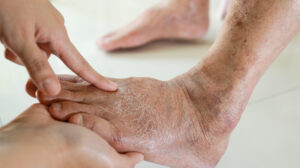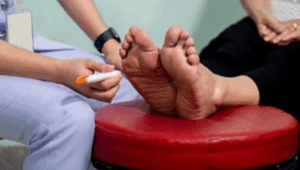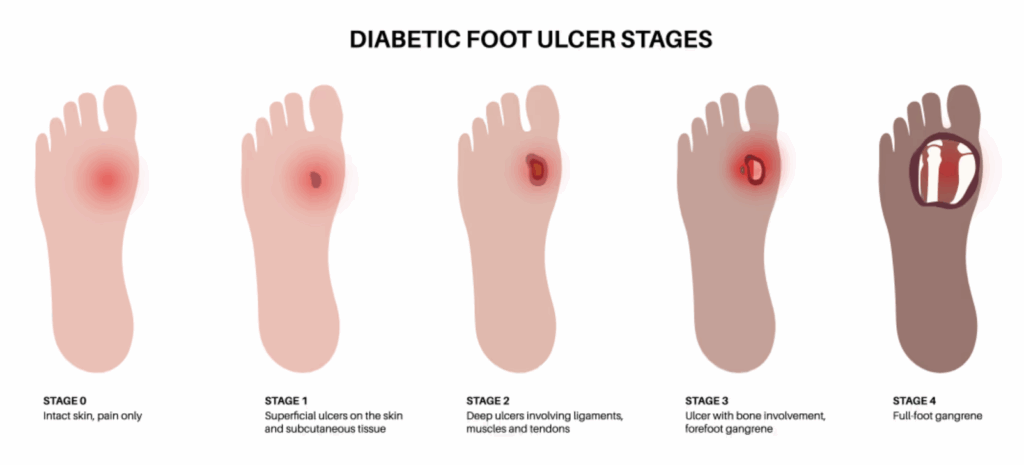The Silent Threat of Peripheral Arterial Disease
September 30 2025
Don’t let leg pain slow you down! September is Peripheral Arterial Disease (PAD) Awareness Month, and it’s time to listen to what your feet are telling you. If you’re experiencing cramping or pain in your legs while walking, it could be a sign of poor circulation. Schedule a check-up with us a t Family Foot & Leg Center to keep your steps strong!
Dr. Sahiba Singh, DPM, AACFAS
Kevin Lam, DPM, FACFAS

September is PAD Awareness Month and the Perfect opportunity to shed light on this serious condition. While the sunshine state is famous for its active, outdoor lifestyle, many Floridians are unknowingly living with a condition that silently threatens their mobility and, in severe cases, their limbs.
PAD is a common circulatory problem where narrowed arteries reduce blood flow to your limbs, most often the legs and feet. It’s caused by atherosclerosis, the same plaque buildup that causes heart disease and stroke. Here in Florida, our demographic – a large population of retirees, couple with lifestyle factors – makes many residents particularly susceptible. The warm weather encourages people to be active, but PAD can make even a simple stroll painful, and many dismiss the symptoms as just a sign of “getting older”.
Recognizing the Symptoms: Don’t Dismiss the Pain
The most common symptom of PAD is claudication, a cramping or aching pain in the leg muscles that occurs during activity and subsides with rest. Patients often describe it as a charley horse that appears every time they walk a certain distance. This is a crucial warning sign. The pain is a direct result of the leg muscles not getting enough oxygen-rich blood to meet the demands of exercise.
every time they walk a certain distance. This is a crucial warning sign. The pain is a direct result of the leg muscles not getting enough oxygen-rich blood to meet the demands of exercise.
However, many patients, especially those with diabetes, may not feel this pain due to nerve damage, a condition known as neuropathy. This makes them even more vulnerable because the disease can progress without any obvious warning signals. This is why regular foot checks are so vital for this population.
Beyond claudication, other symptoms manifest in the feet and lower legs because they are the furthest from the heart and the first to suffer from poor circulation. These include:
- Non-healing sores or wounds on the feet, toes, or legs.
- A noticeable change in skin color, often a pale or bluish tint, especially when the leg is elevated.
- Weak or absent pulses in the feet.
- Slower growth of toenails or hair on the legs.
- A feeling of coldness in one foot or leg compared to the other.
- Burning or aching pain in the feet and toes even while at rest, especially at night.If any of these symptoms sound familiar, please don’t ignore them. Your feet are trying to tell you something.
Why Floridians are at High Risk
The risk factors for PAD are well-documented, and unfortunately, they’re common in the Florida population. The most significant are:
Age: The risk increases with age, particularly after 50. Given Florida’s large retirement community, this is a major factor.
Smoking: Tobacco use is a primary culprit. Smoking damages blood vessels and accelerates atherosclerosis.
Diabetes: Florida has a high prevalence of diabetes, and high blood sugar levels can directly damage arteries and nerves.
High Blood Pressure and High Cholesterol: Both conditions contribute to plaque buildup and the hardening of arteries.
Obesity and a sedentary lifestyle: These factors increase the risk of all the conditions listed above.
Florida’s lifestyle, while often perceived as healthy, can sometimes mask these underlying risks. The hot weather and outdoor activities may seem healthy, but they can distract from the internal health of your circulatory system. The prevalence of these risk factors is why we see so many cases of PAD and its severe complications here at Family Foot & Leg Center.
The Serious Consequences: From Pain to Amputation
Left untreated, PAD can lead to a condition known as Critical Limb Ischemia (CLI). This is a severe form of PAD where blood flow is so restricted that the tissues don’t get enough oxygen even at rest. This leads to excruciating pain, and a simple cut or blister can turn into a chronic, non-healing ulcer.

These wounds are susceptible to infection and can quickly become gangrenous, often necessitating amputation. It’s a stark reality, but Florida has a significant number of limb amputations due to preventable conditions like PAD. We’re on the front lines, and it’s a tragedy to see patients lose their independence and quality of life when early intervention could have saved their limb.
Our Approach at Family Foot & Leg Center
At Family Foot & Leg Center, our mission is to provide comprehensive care that not only treats the symptoms but also addresses the underlying cause of PAD. We begin with a simple, non-invasive diagnostic tool called the Ankle-Brachial Index (ABI), which compares the blood pressure in your ankle to the blood pressure in your arm. A low ABI reading is a strong indicator of PAD.
From there, we work with patients on a personalized treatment plan. This can include:
Lifestyle Modifications: Quitting smoking, regular exercise, and a healthy diet are the cornerstones of management. I often prescribe a supervised exercise program to improve circulation and reduce symptoms.
Medications: We can use medications to manage cholesterol, blood pressure, and blood sugar, as well as to prevent blood clots.
Wound Care: For those with non-healing wounds, our clinic is an advanced wound healing center. We use state-of-the-art techniques and dressings to promote healing and prevent infection.
Referral to a Vascular Specialist: In more advanced cases, we work closely with vascular specialists who can perform minimally invasive procedures like angioplasty or stenting to open blocked arteries and restore blood flow. In severe cases, bypass surgery may be necessary.
My message to Floridians is this: listen to your body. Don’t assume that leg pain or foot problems are just  a normal part of aging. Peripheral Arterial Disease is a serious, progressive condition, but with early diagnosis and proactive treatment, we can manage it effectively, improve your quality of life, and most importantly, keep you walking. Don’t wait for your feet to scream for help – come see us.
a normal part of aging. Peripheral Arterial Disease is a serious, progressive condition, but with early diagnosis and proactive treatment, we can manage it effectively, improve your quality of life, and most importantly, keep you walking. Don’t wait for your feet to scream for help – come see us.
If you are experiencing symptoms of PAD, contact Dr. Singh’s office at (239) 430-3668 (FOOT) or visit www.NaplesPodiatrist.com to schedule an appointment.
Serving Southwest Florida Since 2005, Family Foot & Leg Center has multiple convenient locations throughout Collier, Lee, Charlotte, and Sarasota Counties. Offering pediatric to geriatric family care: Ingrown Toenails, Heel Pain, Bunions, Foot / Ankle Arthritis Pain, Plantar Fasciitis, Foot / Ankle Surgery, Custom Orthotics, and Diabetic Wound Care. In office X-rays, ultrasounds, and minor surgical suite exam rooms. Practice powered by EMR and advanced technologies.
Home of the Lam Minimally Invasive No-Scar Bunion Surgery! Come Discover Why Patients Love Our 5-Star Foot & Ankle Care!
For advanced wound management and diabetic wound healing resources, visit:
👉 WoundHealingExperts.com
Same Day Appointments! Easy Online Appointment Scheduling.

 Fax: (239) 692-9436
Fax: (239) 692-9436 Tel: 239-430-3668
Tel: 239-430-3668